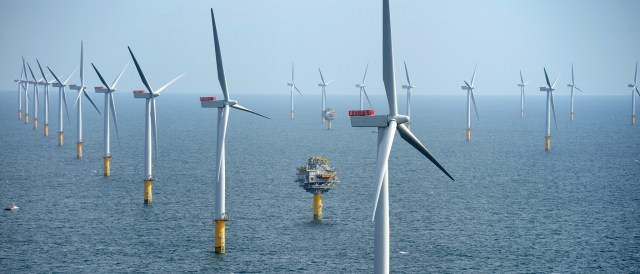Bidding processes are used in various economic sectors, and with good reason. But do those reasons apply to the energy sector – and, in particular, to Germany’s energy transition goals? Craig Morris presents the findings in a recent study by IZES.

The UK utilises reverse auctions as a policy for renewables – at the same time, wind power is more expensive than in Germany. (Photo by Harald Pettersen/Statoil, CC BY 2.0)
Germany is to switch from feed-in tariffs to a system of reverse auctions (see the previous article). To be fair, both of these policy options must be properly designed, and if you get something wrong, the outcome can easily be undesired. The more important question is therefore how likely desired outcomes will be under real-world conditions from the two policy options.
The study says the most attractive thing about reverse auctions is that the government does not have to spend a lot of time trying to find the right market price, as is required for feed-in tariffs; in auctions, bidders reveal the lowest market prices. IZES points out that reverse auctions have proven to be very successful in the construction sector, for instance, both in reducing costs and speeding up projects.
On the other hand, in bidding processes, we hand over decisions about how much needs to be built to a small group of experts designing the competition. Instead of a law requiring parliamentary consent (which Germany has now for feed-in tariffs), reverse auctions would allow the German government to issue decrees for a wide range of factors without any democratic checks and balances: project sizes, deadlines, requirements, procedures, etc. Furthermore, green power from abroad could be purchased towards meeting targets; at present, feed-in tariffs only apply for electricity generated within Germany. All of this, especially international trading of green power, is expressly welcomed towards the further integration of EU power markets.
Free marketeers tend to prefer reverse auctions, in which the market sets the price; they do not seem to mind the government setting the market volume.
Price need not be the only criterion in auctions, however. Quality can be a requirement along with environmental impacts. In my previous post, I mentioned how auctions tend to limit participation only to big firms, and IZES says the specifications can also include a limit on market shares per company. Indeed, the analysts even propose that the cost of submitting proposals could be shared among all applicants to encourage more firms to participate.
Bidders have to make sure they have the land, get the components on time, conduct an environmental impact study, and make sure permitting can take place in addition to fulfilling specifications for the auction. The cost can easily exceed 100,000 euros for a wind farm – for each losing bidder.
The effect of sharing such costs, however, is a higher overall cost for the auction – or, as the authors put it, “the goal of cost efficiency thus fundamentally clashes with the goal of greater market competition.”
Auctions may even intrinsically increase prices by leveraging institutional capital rather than citizen energy co-ops: “institutional investors generally expect greater returns than citizens do.” I have written about how the six percent target return offered by feed-in tariffs is enticing to citizens, whereas German grid firms would prefer 11 percent. Recently, an article in Forbes also pointed out that “major transmission investments” have “a government-guaranteed return of 11.7 to 12.9 percent.”
Indeed, this effect probably even accounts for the much higher prices paid for both onshore and offshore wind in the UK compared to Germany. Given the much better British wind conditions, you would expect the UK’s wind power to cost much less, but in fact more is paid – in part, then, because German citizens drive the onshore wind market in their country and are happy with a smaller return than the corporations behind the UK’s wind sector.
And then there is the problem of “predatory bidding” – when a company bids very aggressively to scare competitors away in future bids. As IZES explains, firms already established in a given market may be willing to pay a price to keep competitors out.
All of these problems can be fixed, of course, but they show that “it is extremely difficult to design a ‘good’ auction, and even little mistakes can lead to very bad results.” But mainly, IZES wonders whether the power sector is comparable to sectors, such as construction, where bidding processes are common. Citizen participation in the Energiewende has increased public acceptance, and wider competition between firms large and small has stepped up innovation – and lowered cost. In contrast, no one aims to have large construction projects done by citizen cooperatives. As I recently mused, maybe the energy sector actually trends away from corporate ownership and towards energy democracy if we let it.
Most of all, the discussion above is still too theoretical. It’s time we take a look at specific outcomes of reverse auctions in a few countries in my next and last post in this series.
Craig Morris (@PPchef) is the lead author of German Energy Transition. He directs Petite Planète and writes every workday for Renewables International.